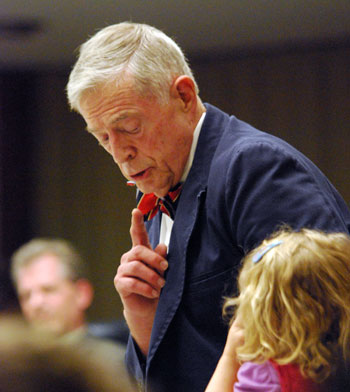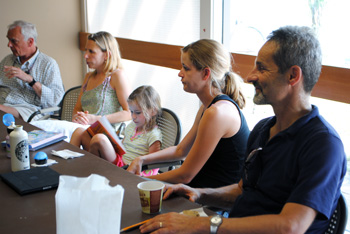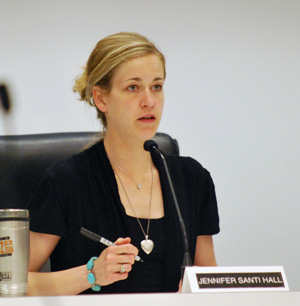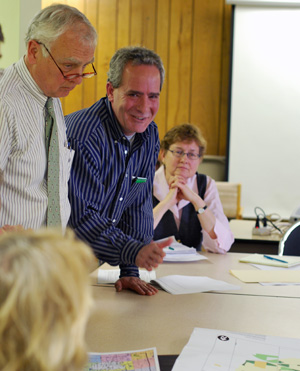More Concerns Aired on Fuller Road Station
Ann Arbor park advisory commission meeting (Nov. 15, 2011): With no action items on the agenda, PAC’s November meeting was filled with updates and honors, farewells and a few pointed comments regarding Fuller Road Station.

At left: Lynn Bowen, an administrative assistant with the city who provides staff support for the park advisory commission, is retiring and was honored at PAC's November meeting. She has worked at the city for 26 years, including the last six years with parks and recreation. To the right are PAC chair Julie Grand and Colin Smith, the city's parks and recreation manager. (Photos by the writer.)
Commissioners were briefed by city staff about annual finances related to the land acquisition for parks and greenbelt programs, which are funded by a 30-year millage. They also got an update on the city’s marketing efforts for parks and recreation, and heard a report on the status of a sustainability project – several PAC commissioners had attended a September joint work session to help prioritize city goals related to environmental quality, economic vitality, and social equity.
Updates were also given about a sediment removal project in the Ruthven Nature Area, and about two parking-related projects at Riverside Park and Veterans Memorial Park.
In his manager’s report, Colin Smith noted that he’d taken a canoe run through the under-construction Argo Dam bypass pools – the new channel was a ”bit sportier” than he had expected, and is still being tweaked. He also told commissioners he’d received word that two state grant applications made by the city of Ann Arbor – $300,000 for the proposed Ann Arbor skatepark at Veterans Memorial Park, and $300,000 for improvements at the Gallup Park canoe livery – had ranked in the top 12 out of 100 applications statewide for funding from the Michigan Natural Resources Trust Fund. That bodes well for the possibility that the grants will be awarded – a decision from the state is expected in December.
During the meeting commissioners also honored two volunteers with the city’s natural area preservation program – Sarah Newman and Drew Lathin – and said farewell to Lynn Bowen, the administrative assistant who works with PAC. The meeting was her last before retiring from the city.
An item not on the agenda – the proposed Fuller Road Station – drew focus from public commentary as well as some questions from commissioners later in the meeting. [Full Story]









